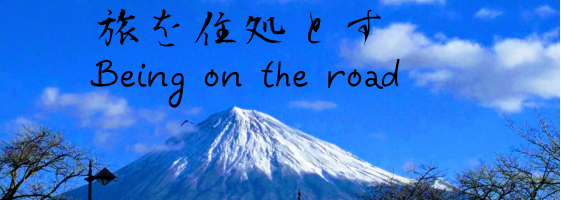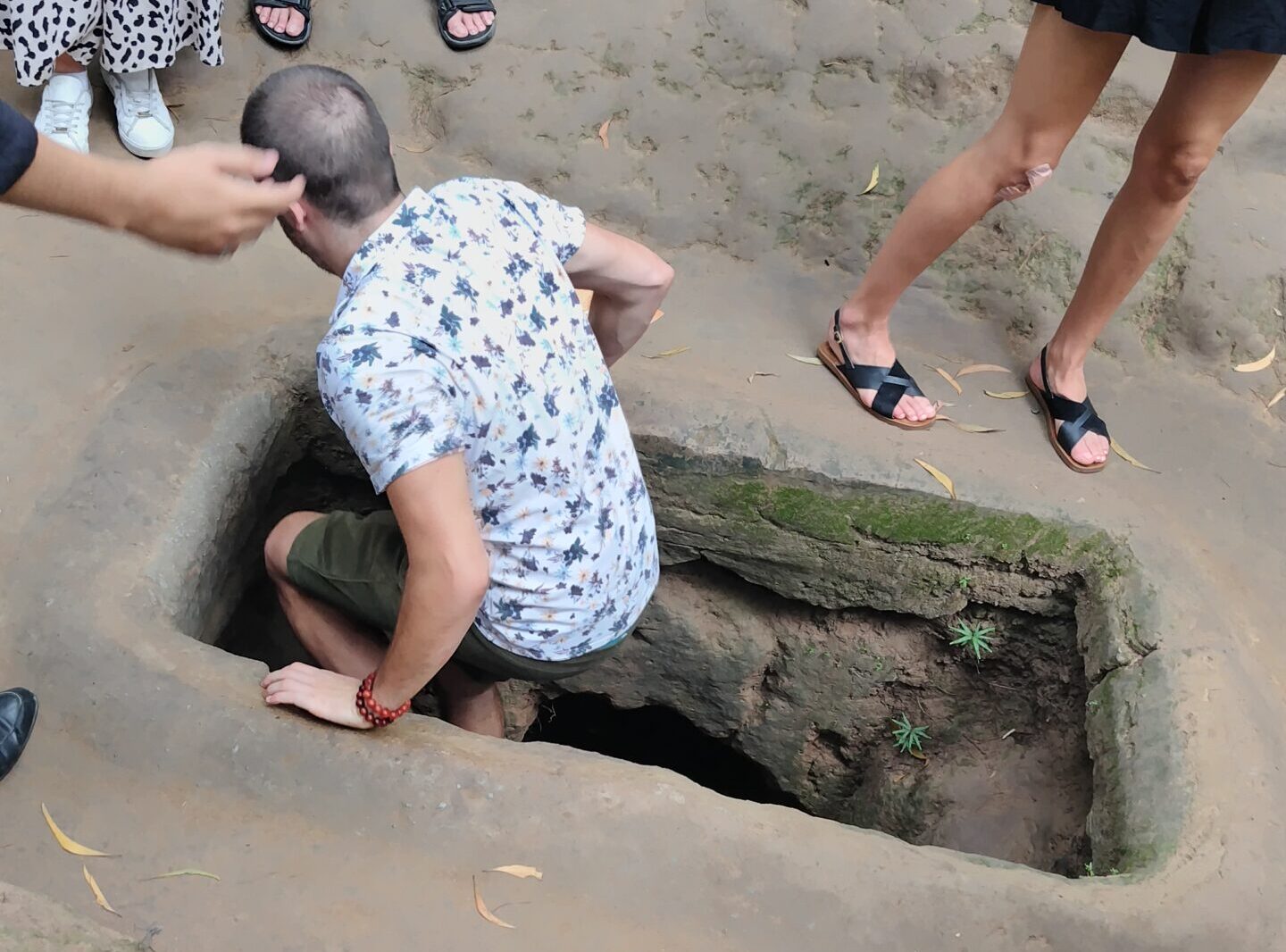In December 2023, I stayed in Ho Chi Minh City, Vietnam. Near Ho Chi Minh City, the Cu Chi Tunnels, a significant Vietnam War site, have been developed as a tourist attraction, and day tours were available, so I participated in one. This article shares information based on my actual experience during that tour.
The Vietnam War and the Viet Cong
What was the Vietnam War?
The Vietnam War was a civil war that occurred in Vietnam, which was divided into North and South, from 1955 to 1975. This conflict was set against the backdrop of international ideological clashes during the Cold War, with forces supported by the United States and the Soviet Union clashing.
Background of the War
- Division of Vietnam: After gaining independence from France, Vietnam was divided into North and South, giving rise to regimes with different ideologies.
- American Intervention: The United States supported South Vietnam to prevent the spread of communism, carrying out bombing campaigns in the North and ground operations.
- Viet Cong Resistance: The National Liberation Front of South Vietnam (Viet Cong), with support from North Vietnam, fought against American forces using guerrilla tactics.
Course and Characteristics of the War
- Prolonged Conflict: The Vietnam War became a long and drawn-out quagmire, leading to heavy casualties for the United States.
- Guerrilla Warfare: The Viet Cong utilized jungles and underground tunnels for guerrilla warfare, posing significant challenges to American forces.
- Agent Orange: The U.S. military also employed inhumane tactics, such as spraying Agent Orange to defoliate the jungles.
- Anti-war Movement: Anti-war movements intensified within the United States, leading to President Nixon’s resignation.
Outcome of the War
In 1975, Saigon fell, and Vietnam was unified. However, the war resulted in many casualties and devastated the country, leaving deep scars on Vietnamese society.
Impact of the Vietnam War
- Vietnam: Vietnam suffered immense damage from years of war. Economic recovery and social stabilization took a long time.
- United States: The Vietnam War left deep scars on the American people and significantly impacted U.S. foreign policy.
- Global: Some believe it accelerated the end of the Cold War structure, profoundly influencing global political dynamics.
Activities of the Viet Cong
The Viet Cong, based among farmers and laborers in South Vietnam, engaged in guerrilla warfare.
- Guerrilla Tactics: They repeatedly launched surprise attacks against U.S. and South Vietnamese government forces, utilizing jungles and underground tunnels.
- Popular Support: The Viet Cong appealed to the people of South Vietnam by advocating for improved living conditions, gaining widespread popular support.
- Coordination with North Vietnam: They continued fighting the South Vietnamese government forces with material and personnel support from North Vietnam.
Cu Chi Tunnels
The Cu Chi Tunnels are an extensive underground tunnel network, stretching approximately 250 km, primarily located in the Cu Chi district northwest of Ho Chi Minh City. During the Vietnam War, the Viet Cong used this underground tunnel system as a living space and a combat base to protect themselves from intense American attacks.
Structure and Function of the Cu Chi Tunnels
- Complex Structure: The tunnels were equipped with all necessary living functions, including residences, hospitals, meeting rooms, weapons factories, and kitchens.
- Ingenious Traps: The tunnels contained various traps to capture intruders, such as pitfalls and booby traps, some with painful-looking blades or pointed metal with barbs. These were likely aimed at reducing enemy combatants rather than killing them, as immobilizing one person would require at least two others to assist.
- Ventilation System: A ventilation system was also in place to bring air into the tunnels, allowing for long-term living.
Cu Chi Tunnels Day Tour
Currently, the Cu Chi Tunnels have been developed as a tourist attraction, offering a glimpse into what life was like during that era.
Joining a Local Tour
I was staying on Pham Ngu Lao Street in Ho Chi Minh City. This area is a popular gathering spot for travelers, with many hotels and travel agencies. Most agencies offer similar tours, and the Cu Chi Tunnels tour is one of them.
While you can reach the Cu Chi Tunnels by connecting local buses, the transfers aren’t always smooth, and considering the potential time loss, a tour might not be much more expensive. In hindsight, I wonder if it’s even possible to enter individually, and even if so, it would be difficult without a guide’s explanation.
I found an agency that offered a 400,000 VND (approx. 2,400 JPY) tour for 300,000 VND (approx. 1,800 JPY), so I joined that one. (Prices are based on the exchange rate at the time.)
Tour Day Flow
On the day of the tour, I was picked up by a van at the agency on Pham Ngu Lao at 8 AM. The van picked up other passengers at several points before officially departing. There were about a dozen passengers, mostly Europeans. I was the only Japanese person, and there was one young Korean couple. I wondered if the absence of Americans was coincidental, or if, given the historical context of the Vietnam War battleground, it’s a tour that Americans might find difficult to participate in. I’m not sure if the Korean couple knew about the history beforehand or participated unknowingly due to their youth.
We stopped at a local craft exhibition and sales center along the way, and then arrived at the Cu Chi Tunnels in about an hour of actual travel time.
Our guide was a young Vietnamese man who explained everything fluently in English. I heard that there are also tours with Japanese guides online, but the price was considerably higher, so you might want to look into it if it’s absolutely necessary for you.
Facility Explanation and Vietnam War Footage
After completing the admission procedures, we first watched a documentary video about the Cu Chi Tunnels historic site and the Vietnam War. It was about 20 minutes long. Admission seems to be sectioned by time, with about 100 people in the hall at once. After the explanation, we returned to our groups and started from different spots. This arrangement helps prevent large crowds from congregating at one place.
Visiting Each Spot
- Numerous pitfalls and traps are scattered around the area. Small groups proceed and receive explanations at each spot.
You can actually enter hidden holes where the Viet Cong would hide. Since not everyone in the group can enter at once, it’s done in groups of a few people.
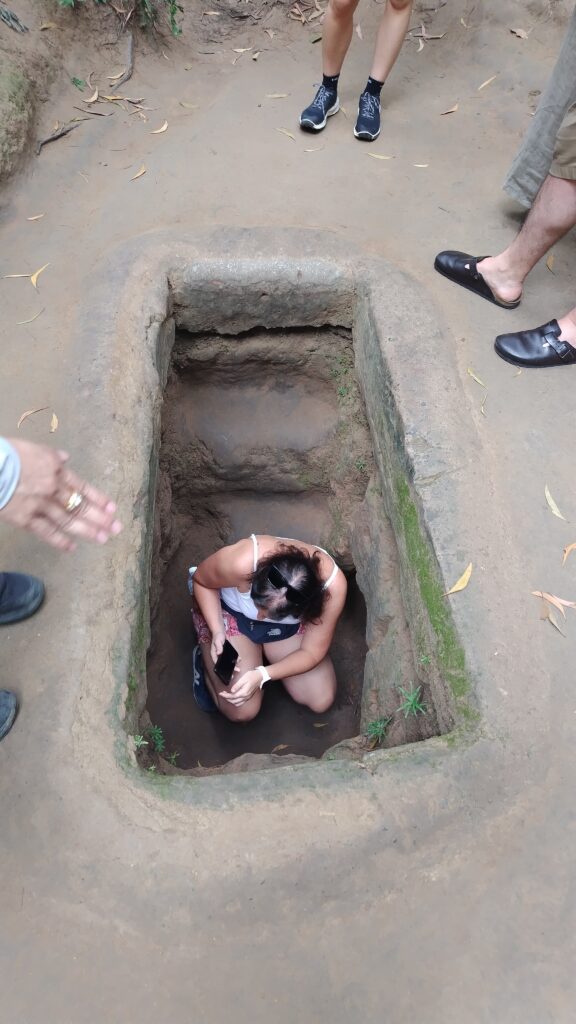
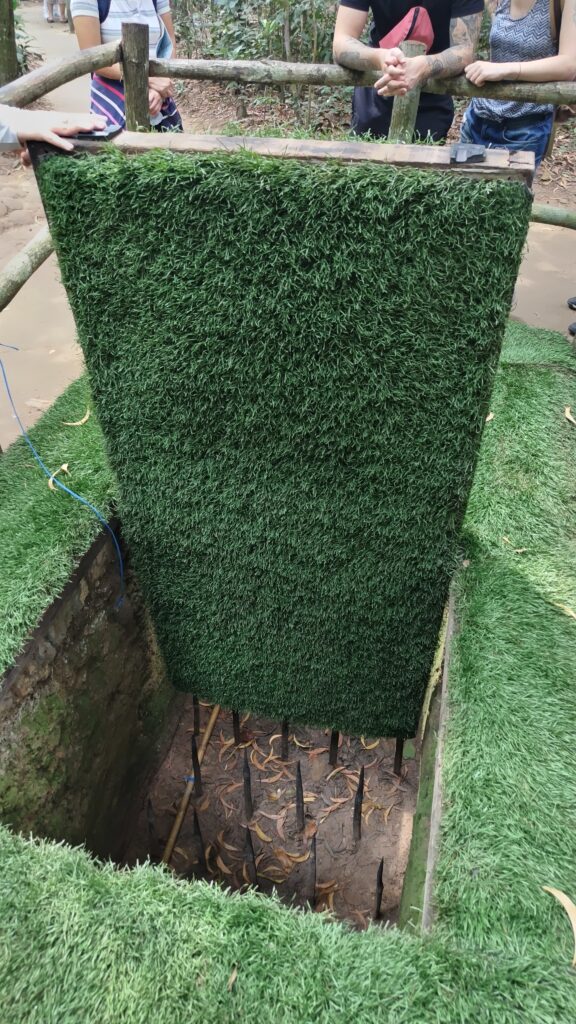
We received explanations about the traps. The holes contained blades and sharp metal objects, some with barbs, which looked painful just to see. If one person was incapacitated, at least two others would be needed to support them, so I believe the aim was to reduce fighting force rather than outright killing.
There were also factories that made weapons from cannon shell metal and sandals from tire rubber.
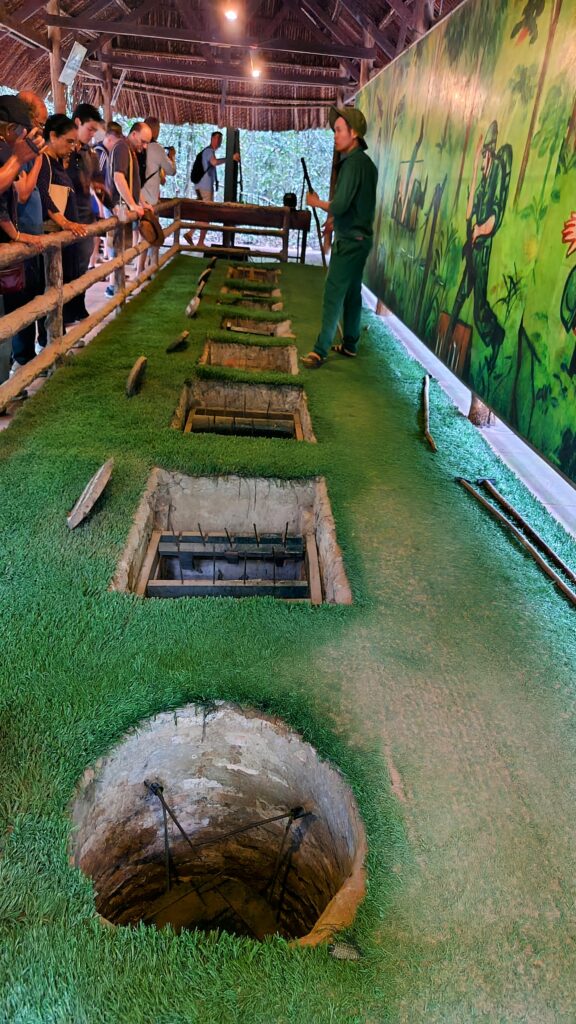
Finally, there’s a spot where you can actually enter an underground tunnel. This hole is so small and narrow that only a small Viet Cong person could barely fit through, making it inaccessible for larger Europeans or those wearing clothes that shouldn’t get dirty. You have to crawl through in a crouch or on all fours, which is a very strenuous posture. It’s only tens of meters long, but there are exit points along the way for those who feel they can’t make it to the end.
Finally, the tour concludes with a lunch replicating the meals eaten by the Viet Cong, which consisted of steamed taro and tea.
Live Firing Option
Although not part of the standard tour menu, there is an option to try live firing of real guns, rifles, and machine guns at the facility. Those interested can apply on-site the day of the tour.
Depending on the size of the gun, a single live round costs about 300 JPY and up. This is an experience you absolutely cannot have in Japan, so those interested might consider it. I had been thinking about it until I arrived at the site, but once I heard the sound of the gunfire and experienced the sheer volume and eerie atmosphere, fear took over, and I decided not to participate. The reception and the actual firing range were a bit separated, but even so, it hurt my ears if I didn’t cover them. The atmosphere was completely different from shooting scenes in movies or TV. I wonder what kind of psychology leads someone to want to fire live ammunition after experiencing the battlegrounds of the Vietnam War.
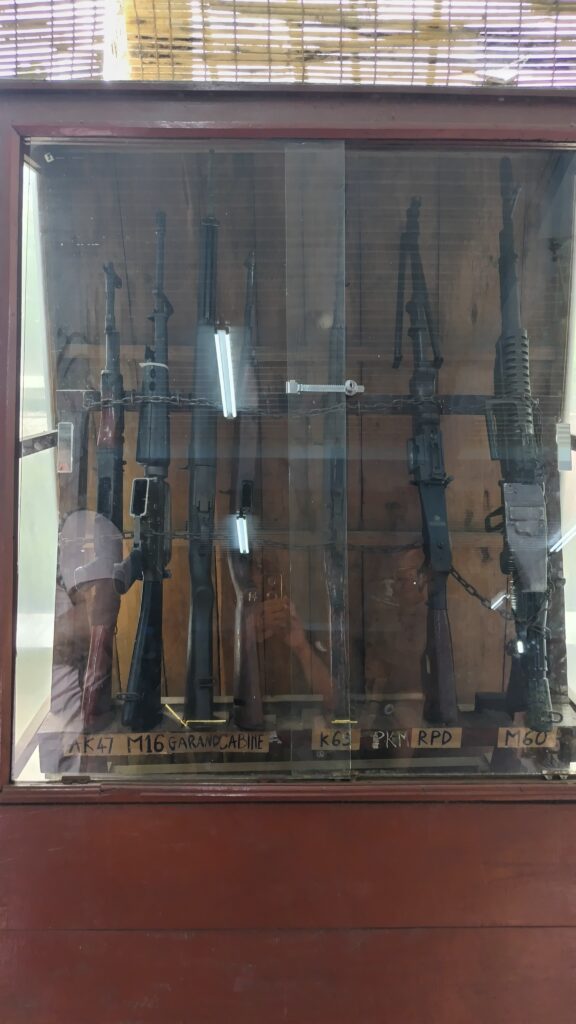
Important Notes When Visiting the Cu Chi Tunnels
- Physical Condition: The tunnels are narrow and humid, so if you are not confident in your physical stamina, it’s best not to enter the holes.
- Attire: Wear clothes that can get dirty, long pants, and athletic shoes, and be fully prepared for the heat.
Conclusion
This was an experience unlike typical sightseeing tours. It’s close enough to Ho Chi Minh City for a day trip. If an English-speaking guide is acceptable, local tours are offered at affordable prices. You might consider it if you’re visiting Ho Chi Minh City.
However, I recommend participating with prior knowledge of the Vietnam War, the Viet Cong, Agent Orange, and issues like Lai Dai Han.
